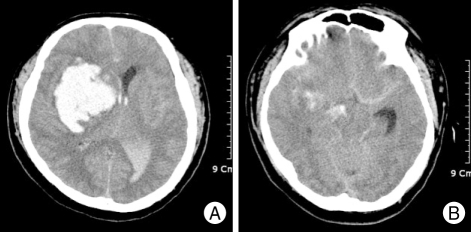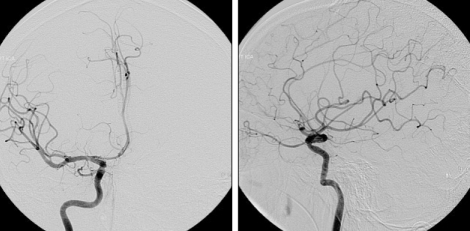Abstract
Sildenafil citrate (Viagra®; Pfeizer US Pharmaceutical Group, New York, NY, USA) is a potent vasodilating agent to treat male erectile dysfunction. Among its adverse effects, hemorrhagic stroke has not been widely reported yet. We present a case of a 33-year-old healthy man who ingested 50 mg sildenafil a half hour before onset of headache, nervousness and speech disturbance. Head computed tomogram of this stuporous man showed huge intracerebral hemorrhage and thick subarachnoid hemorrhage, but angiography failed to disclose any vascular anomalies. Subsequent surgical procedure was followed, and rehabilitation was provided thereafter. Sildenafil seems to act by redistributing arterial blood flow, and concurrent sympathetic hyperactivity, which lead to such hemorrhagic presentation. Extreme caution should be paid on even in a young adult male patient wven without known risk factors.
Keywords: Intracerebral hemorrhage, Risk factors, Sildenafil, Subarachnoid hemorrhage
INTRODUCTION
For a decade, sildenafil citrate (Viagra®; Pfeizer US Pharmaceutical Group, New York, NY, USA) has become one of the top-selling product in the world-wide market for male impotence treatment. Since its first introduction however, numerous adverse effects have been reported, and particular attention should be paid upon when prescription is considered. With regard to intracerebral hemorrhage (ICH), there are only four English written literatures1,4,9,10). All of these cases showed minimal-to-moderate degree hemorrhage with unremarkable recovery.
We experienced a case of massive ICH associated with subarachnoid hemorrhage (SAH) requiring surgical removal. This young male patient did not have any risk factors for hemorrhage. A detailed case report and possible pathophysiologic explanations are presented.
CASE REPORT
A 33-year-old man was brought in to the Emergency Room for sudden unconsciousness following paroxysmal headache, nervousness and speech disturbance of two-hour duration. Approximately a half hour prior to symptom onset, he ingested one tablet of 50 mg sildenafil citrate to attempt sexual intercourse, but he could not.
Although he was slightly overweight (178 cm, 88 kg), he had been healthy and free of any significant medical history, including arterial hypertension, diabetes, hyperlipidemia, migraine, pre-existing cardiovascular or cerebrovascular diseases. He took no other medications, except episodic common-cold remedies. He had a 15-year history of tobacco smoking (approximately 1 pack per day), and ingested irregular alcohol about two times per week, presumably more than social drinking. He had been married 35 days before this event, and had taken sildenafil citrate 25 mg for two times during recent 2 weeks that were prescribed by a urologist. His wife denied any similar symptoms when used previously.
On admission, he was profoundly stuporous, densely quapriparetic (Grade 3/Grade 1), and had fully dilated pupils. Vital signs showed high blood pressure of 160/95 mmHg, rapid pulse rate (108/min) and respiration (24/min), and fever up to 38.5℃ , respectively. Brain computed tomography (CT) showed a huge ICH on the right basal ganglia, intraventricular clots and thick SAH (Fig. 1). A CT angiography and trasnfemoral catheter angiography (TFCA) failed to disclose any vascular lesion on the corresponding hemisphere (Fig. 2).
Fig. 1.
Admission head computed tomograms show huge hemorrhage on the right basal ganglia and ventricles (A), in addition to diffuse subarachnoid hemorrhage (B).
Fig. 2.
Right carotid angiograms only show displacement of the anterior and middle cerebral arteries without any anomalous cerebral vasculatures.
Because of impending herniation, we hurried him into the operating room for decompression. Following dural reflection, swollen brain was encountered, and prompt temporal corticectomy was conducted to find organizing hematoma. After gentle suction and irrigation of hematoma, the sylvian fissure was widely split to show most course of the right middle cerebral artery (MCA). From distal portion, the MCA was thoroughly inspected up to the proximal MCA, but we could not find any aneurysmal dilatation or other angiomatous lesions. Meticulous hemostasis and expansive duroplasty was done. Skull flap was not covered to control raised intracranial pressure.
Postoperatively, he remained stuporous, but motor function was slightly improved (Grade 5/Grade 1). While in the intensive care unit stay, blood laboratory tests and serologic tests were undertaken, but there were no proven clues for the intracranial bleeding. Afterwards, robust rehabilitation was followed, and cerebrospinal fluid diversion and cranioplasty was performed for delayed hydrocephalus and skull defect, at postoperative 40 days (Fig. 3). At the last follow-up visit, 18 months postoperatively, he regained consciousness, was able to communicate with care givers in restricted extent, but was still hemiparetic (Grade 5/Grade 3) on wheel-chair and dependent for commanding major activities of daily living.
Fig. 3.
A computed tomograms scan following cranioplasty and ventriculopritoneal shunting obtained on postoperative 3rd day.
DISCUSSION
Causes of ICH in a non-hypertensive subject are largely divided into structural vascular anomalies (arteriovenous malformation, aneurysm, moyamoya disease, amyloid angiopathy), and dysfunctional coagulation (coagulopathy, drugs). Drug-induced ICH is mostly attributed to anticoagulants, thrombolytics, sympathomimetics, metamphetamine, or cocaine1). Although there are four previous reports about ICH after sildenafil use, all of these were manifested as minimal volume hemorrhage in elderly with risk factors and thus, surgical evacuation was not required1,4,9,10). The present case mimics either diffuse, thick SAH from rupture of the proximal MCA aneurysm, or massive ICH leaking into the ventricles and subarachnoid space. With the aid of angiography, possibility of vascular anomaly was discarded. The cause and effect relationship of sildenafil and ICH herein, can be established when considering close temporal relationship between sildenafil ingestion and onset of neurological symptoms, within 2 to 4 hours of presumed peak level in blood, due to ICH in a patient without risk factors and non-specific blood laboratory results6,14).
Sildenafil (UK-92,480), an orally active, selective inhibitor of phosphodiesterase type 5 (PDE-5), is a crucial regulator of cyclic guanosine monophosphate (cGMP) and at first intention, it is manufactured aiming at the corpus cavernosum of the human male. It plays a role in causing muscle relaxation, vasodilatation and penile erection by increasing concentration of cGMP and nitrous oxide (NO) in the smooth muscle of the corpus cavernosum3). Side effects of sildenafil, including flushing, headache, nasal congestion, and changes in pulmonary blood flow can tell us that such vasodilatory effect is not confined to the corpus cavernosum11,12). This drug also redistributes the arterial flow, and decreases perfusion, consequently may lead to acute myocardial infarction. For the above reasons, it lowers systolic blood pressure by 8 to 10 mmHg in clinical trials14).
Several ischemic manifestations, such as transient ischemic attack, ischemic stroke, cerebral infarction, or ischemic optic neuropathy can be explained by the above mechanisms8). Vasodilatory effect of sildenafil may also cause atrial fibrillation, provoke atrial thrombi and cardioembolism in a pre-existing cardiomyopathic patient by increasing pressure gradient over the left ventricular outflow tract2). On the other hand, hypotension could lead to secondary sympathetic hyperactivity8,12). Hypotension, cardiac arrhythmia, and rebound sympathetic hyperactivity seems to play concerted roles in producing stroke, especially in ischemic stroke. In previous literatures, we could not find any linear relationship between drug dosage (25 mg, 50 mg, 100 mg) and occurrence of stroke1,4,5,7-10). But, all cases were associated with utilizing more than 50 mg once or twice in a short period. An unknown process of sensitization may be involved however, the mode of drug action in large part, may be not cumulative but idiosyncratic.
The reported occurrence of headache, dizziness, visual disturbances, retinal dysfunction, and a pupil-sparing oculomotor palsy suggest that sildenafil affects regulation of the cerebral microvasculature. In addition to a selective action on PDE-5, sildenafil may act on other two types of PDE (PDE-1 and PDE-2), which are involved in control of cerebral vasculature6,13). To date, there has been no clear evidence to explain pertinent mechanisms of ICH associated with sildenafil.
In summary, sildenafil may act by redistributing arterial blood flow, hence rendering brain tissue more inappropriate perfusion, presenting as prodromes of headache, nervousness and speech disturbance as shown in the current case. Ensuing sympathetic hyperactivity through PDE-1 and PDE-2 might lead to rupture of vessels. Although it is contrary to common belief, we suggest that these inciting and propagating factors for ICH even in a young adult male patient without known risk factors should be warned before prescribing sildenafil.
CONCLUSION
Sildenafil is a potentially dangerous drug, which can provoke life-threatening ICH and SAH in a young adult male. When considering usage, careful discussion and premedication work-up with urologist is mandatory. Adverse effect, such as headache, nervousness, dizziness or speech disturbance should be promptly diagnosed to minimize sequelae.
References
- 1.Alpsan MH, Bebek N, Ciftci FD, Coban O, Bahar S, Tuncay R. Intracerebral hemorrhage associated with sildenafil use : a case report. J Neurol. 2008;255:932–933. doi: 10.1007/s00415-008-0618-z. [DOI] [PubMed] [Google Scholar]
- 2.Awan GM, Calderon E, Dawood G, Alpert MA. Acute, symptomatic atrial fibrillation after sildenafil citrate therapy in a patient with hypertrophic obstructive cardiomyopathy. Am J Med Sci. 2000;320:69–71. doi: 10.1097/00000441-200007000-00011. [DOI] [PubMed] [Google Scholar]
- 3.Ballard SA, Gingell CJ, Tang K, Turner LA, Price ME, Naylor AM. Effects of sildenafil on the relaxation of human corpus cavernosum tissue in vitro and on the activities of cyclic nucleotide phosphodiesterase isozymes. J Urol. 1998;159:2164–2171. doi: 10.1016/S0022-5347(01)63299-3. [DOI] [PubMed] [Google Scholar]
- 4.Buxton N, Flannery T, Wild D, Bassi S. Sildenafil (Viagra)-induced spontaneous intracerebral haemorrhage. Br J Neurosurg. 2001;15:347–349. doi: 10.1080/02688690120072513. [DOI] [PubMed] [Google Scholar]
- 5.Egan RA, Pomeranz H. Transient ischemic attack an stroke associated with sildenafil (Viagra) use. Neurology. 2002;59:293–294. doi: 10.1212/wnl.59.2.293-a. [DOI] [PubMed] [Google Scholar]
- 6.Farooq MU, Naravetla B, Moore PW, Majid A, Gupta R, Kassab MY. Role of sildenafil in neurological disorders. Clin Neuropharmacol. 2008;31:353–362. doi: 10.1097/WNF.0b013e31815cd94c. [DOI] [PubMed] [Google Scholar]
- 7.Habek M, Petravić D. Stroke--an adverse reaction to sildenafil. Clin Neuropharmacol. 2006;29:165–167. doi: 10.1097/01.WNF.0000220815.86478.5F. [DOI] [PubMed] [Google Scholar]
- 8.Kim KK, Kim DG, Ku YH, Lee YJ, Kim WC, Kim OJ, et al. Bilateral cerebral hemispheric infarction associated with sildenafil citrate (Viagra) use. Eur J Neurol. 2008;15:306–308. doi: 10.1111/j.1468-1331.2007.02025.x. [DOI] [PubMed] [Google Scholar]
- 9.Martí I, Martí Massó JF. Hemiballism due to sildenafil use. Neurology. 2004;63:534. doi: 10.1212/01.wnl.0000130359.58099.8b. [DOI] [PubMed] [Google Scholar]
- 10.Monastero R, Pipia C, Camarda LK, Camarda R. Intracerebral haemorrhage associated with sildenafil citrate. J Neurol. 2001;248:141–142. doi: 10.1007/s004150170250. [DOI] [PubMed] [Google Scholar]
- 11.Morales A, Gingell C, Collins M, Wicker PA, Osterloh IH. Clinical safety of oral sildenafil citrate (VIAGRA) in the treatment of erectile dysfunction. Int J Impot Res. 1998;10:69–73. doi: 10.1038/sj.ijir.3900354. discussion 73-74. [DOI] [PubMed] [Google Scholar]
- 12.Morgan JC, Alhatou M, Oberlies J, Johnston KC. Transient ischemic attack and stroke associated with sildenafil (Viagra) use. Neurology. 2001;57:1730–1731. doi: 10.1212/wnl.57.9.1730. [DOI] [PubMed] [Google Scholar]
- 13.Uthayathas S, Karuppagounder SS, Thrash BM, Parameshwaran K, Suppiramaniam V, Dhanasekaran M. Versatile effects of sildenafil : recent pharmacological applications. Pharmacol Rep. 2007;59:150–163. [PubMed] [Google Scholar]
- 14.Zusman RM, Morales A, Glasser DB, Osterloh IH. Overall cardiovascular profile of sildenafil citrate. Am J Cadiol. 1999;83:35C–44C. doi: 10.1016/s0002-9149(99)00046-6. [DOI] [PubMed] [Google Scholar]





